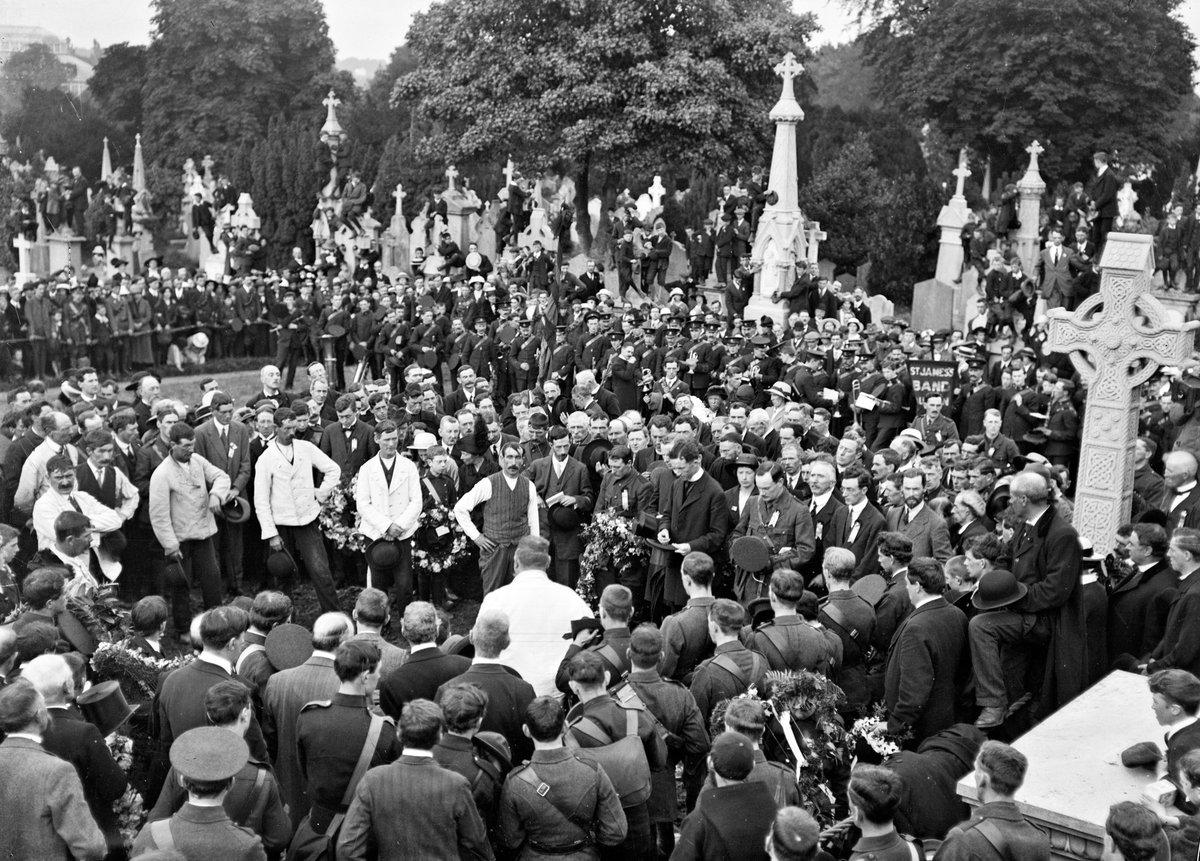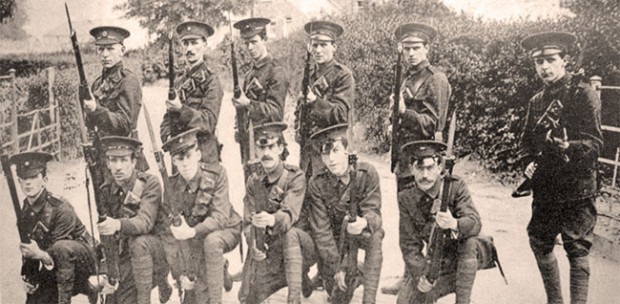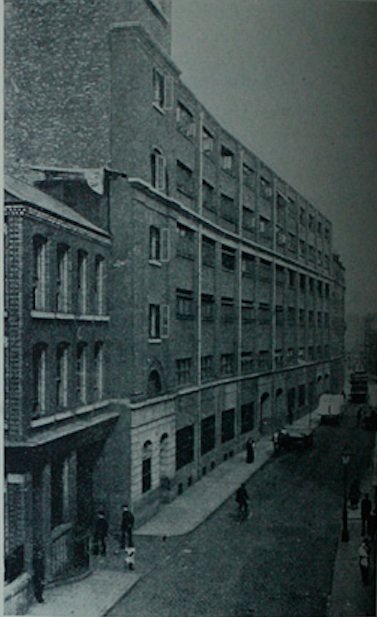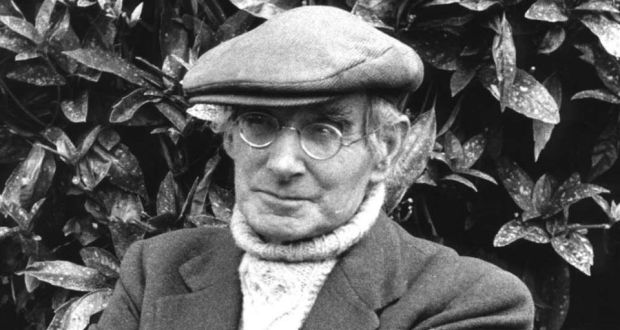Paid a pre-Covid visit to Glasnevin Cemetery to find where my Great-Grandad Frederick Schweppe is buried.
On Glasnevin& #39;s database he& #39;s listed as "Only American citizen to fight in The Easter Rising".
For the day that& #39;s in it, here& #39;s Fred& #39;s story.
On Glasnevin& #39;s database he& #39;s listed as "Only American citizen to fight in The Easter Rising".
For the day that& #39;s in it, here& #39;s Fred& #39;s story.
Born in New York in 1881 to Wilhelm and Mary Bridget Schweppe of Prussia, Fred moved to Boston at a young age, then to Liverpool where he met my Great-Grandmother Mary-Anne Mulhall and joined the Irish Volunteers.
Next stop, Dublin.
Next stop, Dublin.
A member of B Company, 2nd Battalion of the 1st Dublin Brigade, Fred& #39;s Company formed the colour party at the funeral of O& #39;Donovan Rossa where Pearse gave his "Ireland unfree shall never be at peace" oration.
There& #39;s Fred, bottom row, second from left.
There& #39;s Fred, bottom row, second from left.
On Easter Monday, Fred left his home and headed to Jacob& #39;s Biscuit Factory under the command of Thomas McDonagh, later executed for his role in 1916.
Among Fred& #39;s comrades were Bill Stapleton and Vinny Byrne, later members of Michael Collins& #39; Squad.
Among Fred& #39;s comrades were Bill Stapleton and Vinny Byrne, later members of Michael Collins& #39; Squad.
With the Rising quashed, Fred was interred first in Knutsford, Cheshire and then Frongoch, Wales.
There he met Micheal Ó Maoláin, one of a number of Dublin citizens imprisoned post-Rising without having actually fought.
After his release, it was on to 35 Mountjoy Square.
There he met Micheal Ó Maoláin, one of a number of Dublin citizens imprisoned post-Rising without having actually fought.
After his release, it was on to 35 Mountjoy Square.
That& #39;s where playwright Sean O& #39;Casey comes into it.
O& #39;Casey took up a tenement flat alongside Fred, Mary-Anne and, by this stage, their six children.
Raided roughly 18 times by the Black & Tans and the Auxillaries, No 35 become a focal point during the War of Independence.
O& #39;Casey took up a tenement flat alongside Fred, Mary-Anne and, by this stage, their six children.
Raided roughly 18 times by the Black & Tans and the Auxillaries, No 35 become a focal point during the War of Independence.
And it& #39;s where O& #39;Casey set Shadow of a Gunman, basing his character Seumus Shields off Ó Maoláin.
Mary-Anne, a formidable character, later expressed her dislike of O& #39;Casey& #39;s treatment of Ó Maoláin and irked one night when O& #39;Casey jumped under her sheets to hide during a raid.
Mary-Anne, a formidable character, later expressed her dislike of O& #39;Casey& #39;s treatment of Ó Maoláin and irked one night when O& #39;Casey jumped under her sheets to hide during a raid.
Fred, meanwhile, was in-and-out of British prisons for his activities which involved ambushes and holding arms for The Squad.
Bill Stapleton later wrote that Fred Schweppe "was one of the hardest workers on re-organisation after 1916 and was promoted to Section Commander."
Bill Stapleton later wrote that Fred Schweppe "was one of the hardest workers on re-organisation after 1916 and was promoted to Section Commander."
"At the height of hostilities against the British, he was considered by myself and all the officers of the Company, to be one of the most fearless and willing men of the IRA," said Stapleton.
"He was directly responsible for the successful conclusion of many engagements against the British and the fact that he took such grave risks whilst the father of a large family....
...gives some indication of his loyalty to the cause, for I remember isolated cases of single men being unwilling to undertake the highly dangerous enterprises for which he cheerfully volunteered."
By 1921, the War of Independence was nearing its end.
The Treaty was signed in December.
By this stage, Fred& #39;s health had deteriorated. Offered a role in the Free State Army, he declined.
His son, Great-Uncle Fred, would fight on the Anti-Treaty side. He rarely spoke of it.
The Treaty was signed in December.
By this stage, Fred& #39;s health had deteriorated. Offered a role in the Free State Army, he declined.
His son, Great-Uncle Fred, would fight on the Anti-Treaty side. He rarely spoke of it.
Broken in health and financially strained, Fred died in 1928, aged 47.
Mary-Anne was left to raise 9 children aged between 3 and 24.
Mary-Anne was left to raise 9 children aged between 3 and 24.
Luckily, we still have Fred& #39;s Irish Volunteers bandolier.
And from my window along the Royal Canal, can see the plot where him and Mary-Anne are buried.
Sin é folks - Frederick and Mary-Anne Schweppe, rebels.
And from my window along the Royal Canal, can see the plot where him and Mary-Anne are buried.
Sin é folks - Frederick and Mary-Anne Schweppe, rebels.

 Read on Twitter
Read on Twitter





